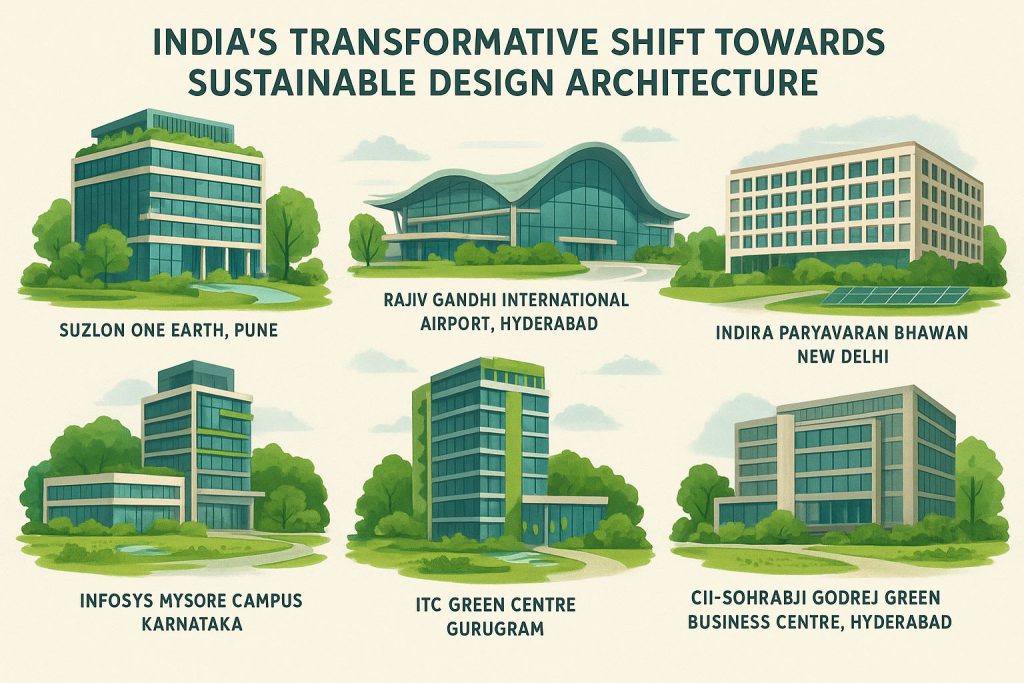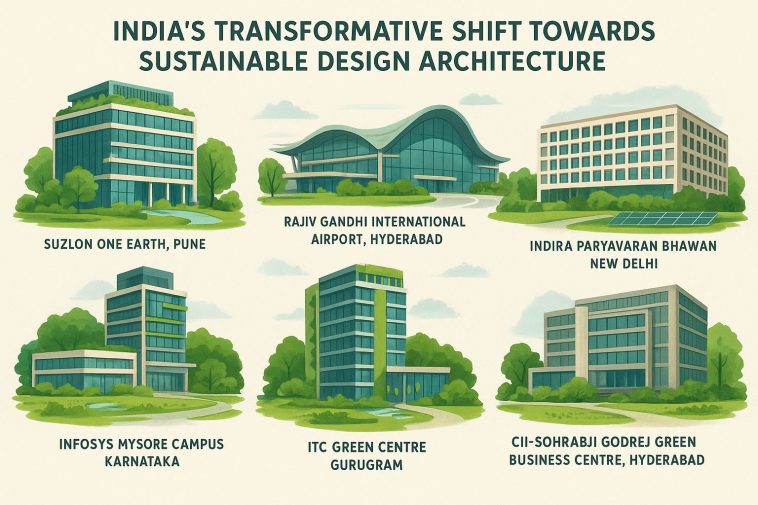10 Landmark Sustainable Design Projects in India are redefining the nation’s architectural landscape by integrating innovation, efficiency, and environmental responsibility. India is undergoing a remarkable transformation toward sustainable design architecture, driven by the growing need to combat climate change and foster eco-friendly urban development.
From energy-efficient buildings and green-certified infrastructures to cutting-edge designs that minimize carbon footprints, these landmark projects highlight India’s unwavering commitment to building a sustainable future. Each development not only enhances functionality and aesthetics but also sets new benchmarks in sustainable urban design and green building practices across the country.

Why These 10 Landmark Sustainable Design Projects in India Matter
India’s architectural landscape is evolving rapidly, with sustainability taking center stage in design and construction. The 10 Landmark Sustainable Design Projects in India represent a significant leap toward creating buildings that are not only aesthetically inspiring but also environmentally responsible. These projects integrate green technologies, renewable energy systems, and eco-friendly materials to minimize carbon footprints while enhancing human comfort and well-being.
From corporate headquarters like Suzlon One Earth in Pune to public infrastructure such as the Rajiv Gandhi International Airport in Hyderabad, each project demonstrates India’s growing expertise in sustainable urban development. These landmarks are setting global benchmarks for LEED-certified architecture, energy efficiency, and smart water management systems.
Moreover, they play a crucial role in shaping India’s future cities—resilient, resource-efficient, and designed in harmony with nature. By embracing sustainable design principles, India is paving the way for a greener tomorrow where innovation and environmental consciousness go hand in hand.
1. Suzlon One Earth, Pune
Suzlon One Earth, located in Pune, stands as a beacon of sustainable corporate architecture.
Designed by the renowned architectural firm, the building has achieved LEED Platinum and GRIHA 5-star certifications, showcasing its commitment to environmental stewardship.
Key Features:
- Rainwater Harvesting: An extensive system that captures and reuses rainwater, reducing dependency on external water sources.
- On-Site Waste Management: Innovative waste conversion techniques minimize landfill contributions.
- Biophilic Design: Landscaped courtyards and green spaces enhance employee well-being and promote biodiversity.
- Energy Efficiency: The building’s design maximizes natural daylight and ventilation, reducing energy consumption.
Suzlon One Earth exemplifies how integrating sustainable practices into corporate design can lead to significant environmental and operational benefits.
2. Rajiv Gandhi International Airport, Hyderabad
Commissioned in 2008, Rajiv Gandhi International Airport in Hyderabad is a pioneering example of sustainable infrastructure in the aviation sector.
It was the first airport in Asia and the second globally to receive a LEED Silver certification.
Sustainable Features:
- Energy-Efficient Systems: Implementation of intelligent lighting and HVAC systems to minimize energy use.
- Water Conservation: Rainwater harvesting and wastewater recycling systems ensure efficient water management.
- Green Landscaping: Extensive green spaces and native plantings reduce the urban heat island effect.
The airport’s commitment to sustainability sets a benchmark for future infrastructure projects in India.
3. Indira Paryavaran Bhawan, New Delhi
Located in the heart of the capital, Indira Paryavaran Bhawan serves as a model for government buildings embracing sustainable design.
Completed in 2014, it is a Net Zero Energy Building (NZEB), producing as much energy as it consumes.
Notable Features:
- Solar Power Generation: A 100 kW rooftop solar panel system meets the building’s electricity needs.
- Natural Ventilation: The Earth Air Tunnel System facilitates passive cooling and ventilation.
- Sustainable Materials: Use of fly ash bricks and low-VOC paints contributes to healthier indoor air quality.
- Water Management: Rainwater harvesting and efficient irrigation systems support water conservation efforts.
Indira Paryavaran Bhawan exemplifies how government buildings can lead by example in sustainable design.
4. ITC Green Centre, Gurugram
ITC Green Centre in Gurugram is a testament to the integration of sustainability in commercial real estate.
Awarded LEED Platinum certification, the building incorporates several eco-friendly features.
Sustainable Design Elements:
- Energy Efficiency: High-performance glass and double-glazed windows reduce energy consumption.
- Water Conservation: Advanced wastewater treatment and rainwater harvesting systems are in place.
- Indoor Air Quality: Use of low-emission materials ensures a healthy indoor environment.
- Green Landscaping: Lush green areas enhance the aesthetic appeal and promote biodiversity.
ITC Green Centre demonstrates how commercial buildings can achieve high sustainability standards while maintaining functionality.
5. Infosys Mysore Campus, Karnataka
Spanning over 300 acres, the Infosys Mysore Campus is a model of sustainable design in the IT sector.
The campus integrates various green building practices to minimize its environmental footprint.
Key Sustainable Features:
- Rainwater Harvesting: An extensive system captures and reuses rainwater for landscaping and other non-potable uses.
- Energy Efficiency: The campus utilizes energy-efficient lighting and HVAC systems to reduce energy consumption.
- Green Spaces: Landscaped courtyards and open spaces enhance the aesthetic appeal and provide recreational areas for employees.
- Waste Management: On-site waste treatment facilities ensure responsible waste disposal and recycling.
Infosys Mysore Campus showcases how large-scale IT campuses can integrate sustainable practices into their design and operations.
6. CII-Sohrabji Godrej Green Business Centre, Hyderabad
Established in 2004, this center is a pioneering example of sustainable business infrastructure in India.
It was the first building in India to receive the LEED Platinum certification.
Sustainable Design Highlights:
- Energy Efficiency: The building’s design incorporates passive cooling and natural lighting to reduce energy consumption.
- Water Conservation: Rainwater harvesting and greywater recycling systems are implemented to conserve water resources.
- Sustainable Materials: Use of recycled materials and low-emission paints contributes to a healthier indoor environment.
- Green Landscaping: Indigenous plants are used in landscaping to promote biodiversity and reduce water usage.
CII-Sohrabji Godrej Green Business Centre sets a high standard for sustainable business infrastructure in India.
7. The Capital, Mumbai
Located in the Bandra Kurla Complex, The Capital is a 19-story commercial building that integrates advanced green technologies.
It has achieved a Gold LEED certification, reflecting its commitment to sustainability.
Green Building Features:
- Automated Parking System: The world’s largest automated car parking system reduces land use and energy consumption.
- Energy Efficiency: Double-glazed glass exterior and energy-efficient lighting systems minimize energy use.
- Indoor Air Quality: The building’s design ensures 30% higher air quality than standard requirements.
- Natural Daylight: 79.2% of regularly occupied spaces receive adequate daylight, reducing the need for artificial lighting.
The Capital demonstrates how integrating advanced technologies can lead to significant sustainability achievements in commercial buildings.
8. Vivanta by Taj, Bengaluru
Vivanta by Taj in Bengaluru is a luxury hotel that incorporates sustainable design principles to minimize its environmental impact.
The hotel has received recognition for its efforts in green building practices.
Sustainable Design Features:
- Energy Efficiency: The hotel utilizes energy-efficient lighting and HVAC systems to reduce energy consumption.
- Water Conservation: Rainwater harvesting and wastewater recycling systems are implemented to conserve water resources.
- Sustainable Materials: Use of eco-friendly materials in construction and interiors contributes to a healthier environment.
- Green Landscaping: Lush green areas enhance the aesthetic appeal and promote biodiversity.
Vivanta by Taj exemplifies how luxury hospitality can align with sustainable design principles.
9. CEPT University Campus, Ahmedabad
CEPT University in Ahmedabad is a premier institution that integrates sustainable design into its campus planning.
The campus is recognized for its efforts in promoting environmental sustainability.
Sustainable Campus Features:
- Energy Efficiency: The campus buildings are designed to maximize natural ventilation and lighting, reducing energy consumption.
- Water Conservation: Rainwater harvesting and efficient irrigation systems support water conservation efforts.
- Sustainable Materials: Use of local and eco-friendly materials in construction minimizes environmental impact.
- Green Spaces: Landscaped areas provide recreational spaces and enhance the campus’s aesthetic appeal.
CEPT University demonstrates how educational institutions can lead in sustainable campus design.
10. Grand Chola, Chennai
Grand Chola, a luxury hotel in Chennai, has integrated sustainable design practices to minimize its environmental footprint. The hotel has received recognition for its green building initiatives.
Sustainable Design Highlights:
- Energy Efficiency: The hotel employs energy-efficient lighting and HVAC systems to reduce energy consumption.
- Water Conservation: Rainwater harvesting and wastewater recycling systems are implemented to conserve water resources.
- Sustainable Materials: Use of eco-friendly materials in construction and interiors contributes to a healthier environment.
- Green Landscaping: Lush green areas enhance the aesthetic appeal and promote biodiversity.
Conclusion
India’s journey toward sustainable design architecture reflects a powerful blend of innovation, responsibility, and foresight. From eco-conscious corporate structures like Suzlon One Earth and ITC Green Centre to pioneering public infrastructures such as the Rajiv Gandhi International Airport and Indira Paryavaran Bhawan, these projects embody a nationwide commitment to environmental stewardship. Each structure integrates energy efficiency, water conservation, and the use of sustainable materials — redefining how modern architecture can coexist harmoniously with nature.
As India continues to urbanize, green building practices and sustainable architectural solutions are no longer optional but essential for shaping resilient and livable cities. These groundbreaking projects not only reduce environmental impact but also set global benchmarks for sustainable development. The country’s architectural evolution proves that growth and sustainability can progress hand in hand, creating a greener, smarter, and more sustainable future for generations to come.


